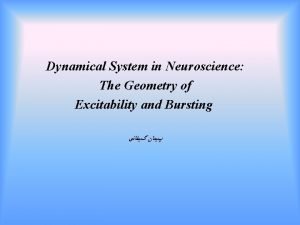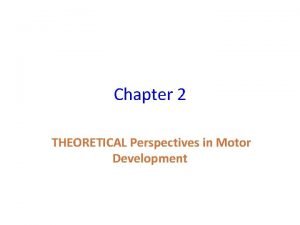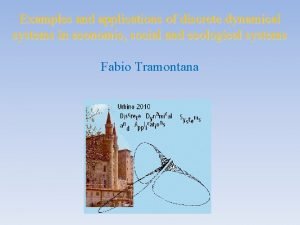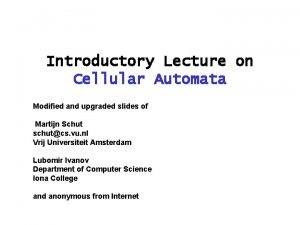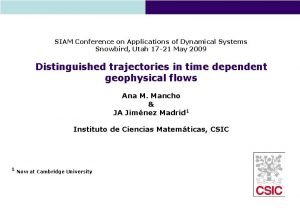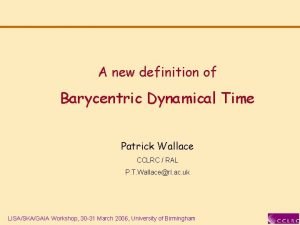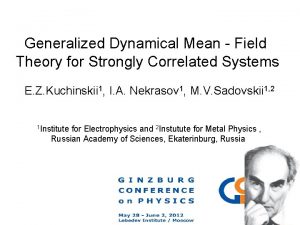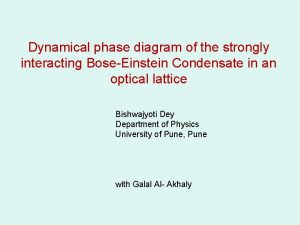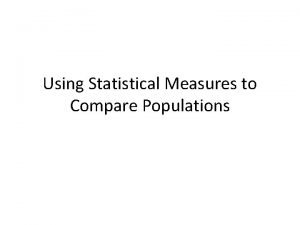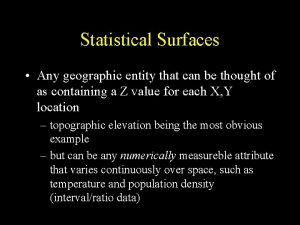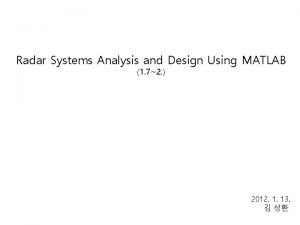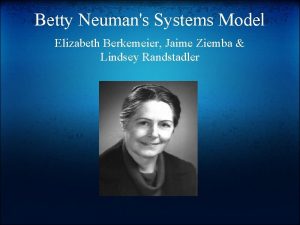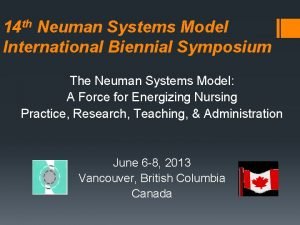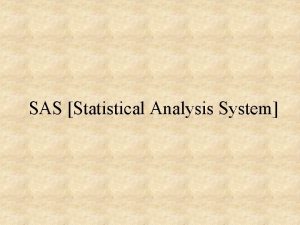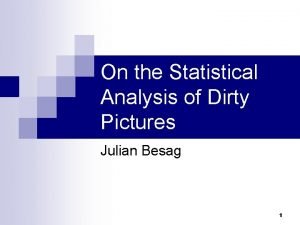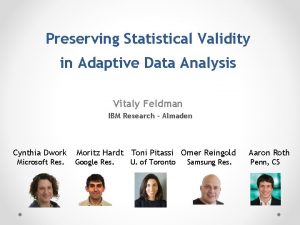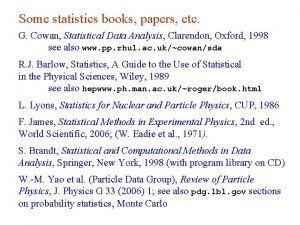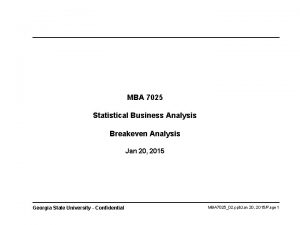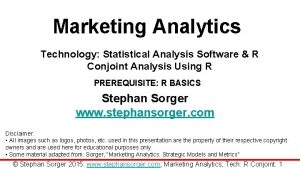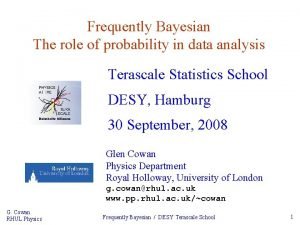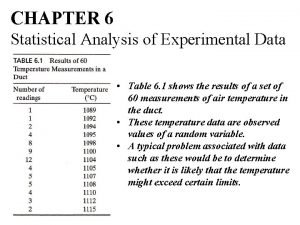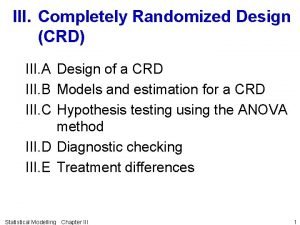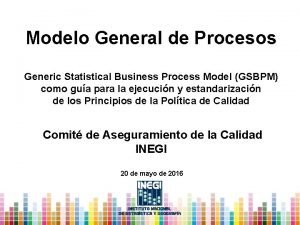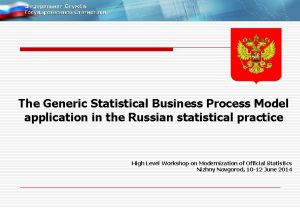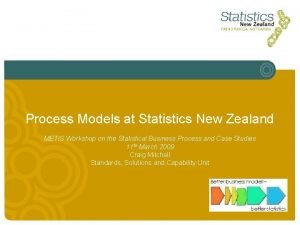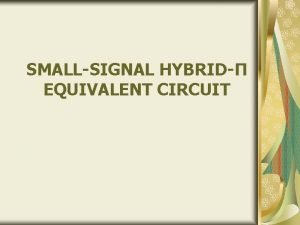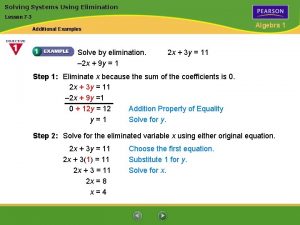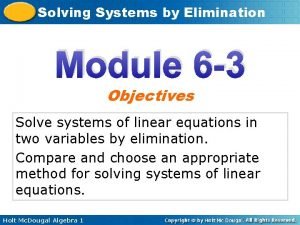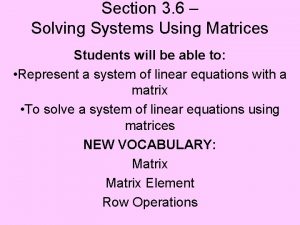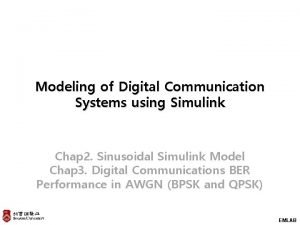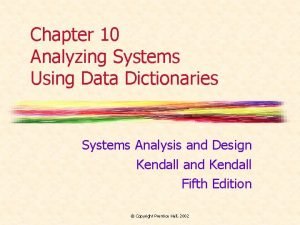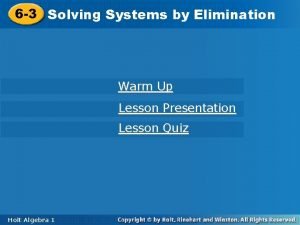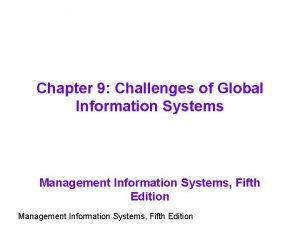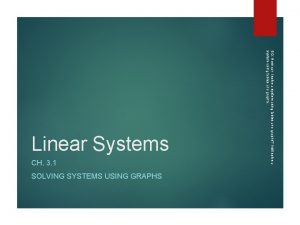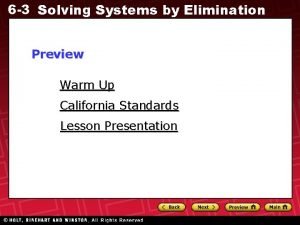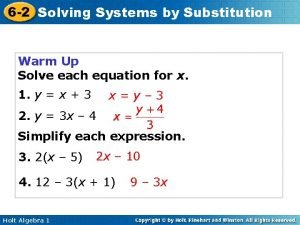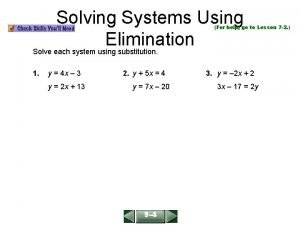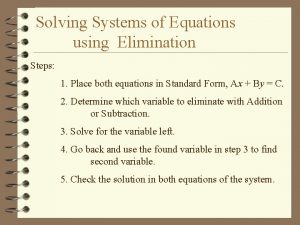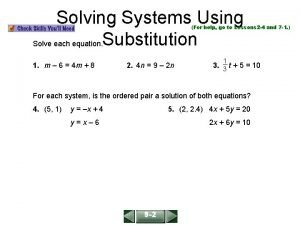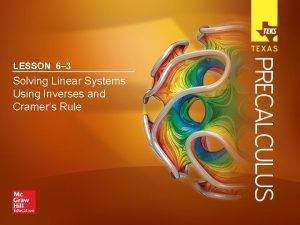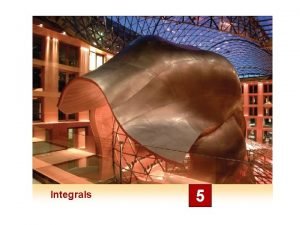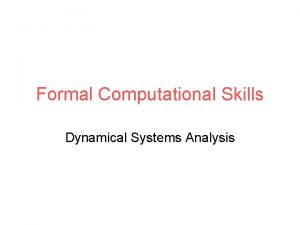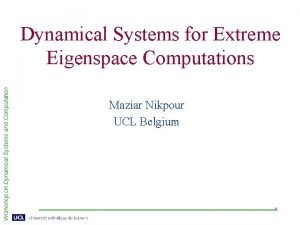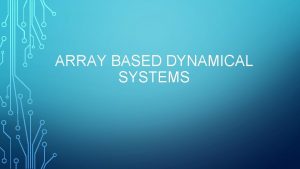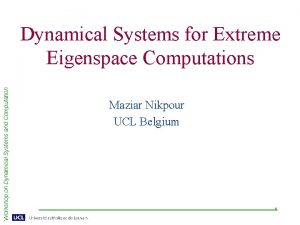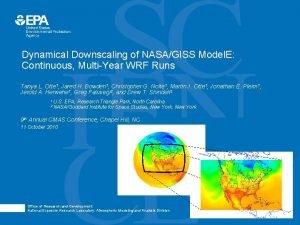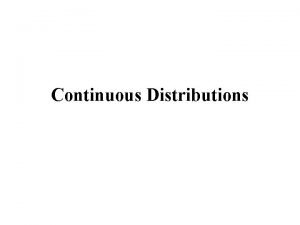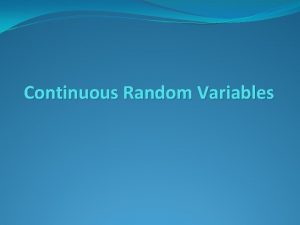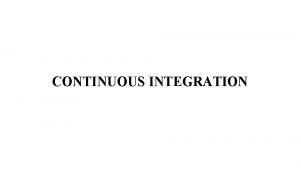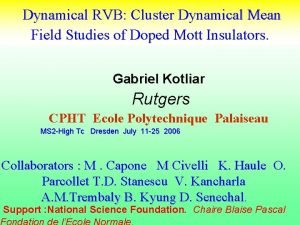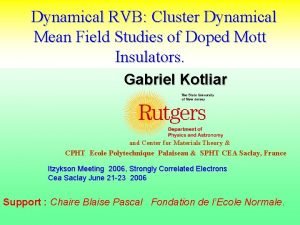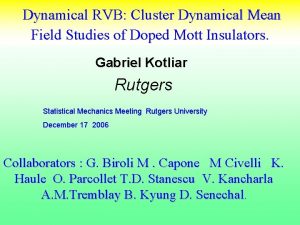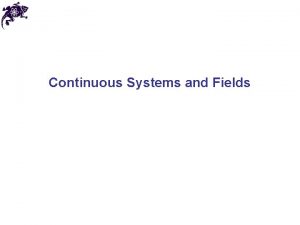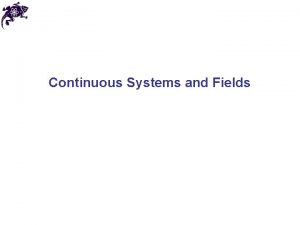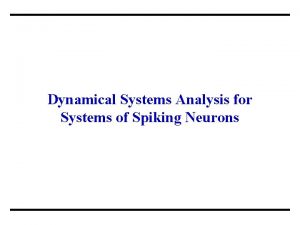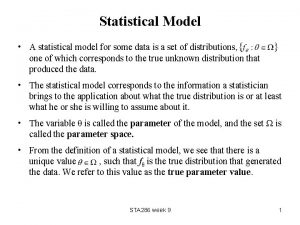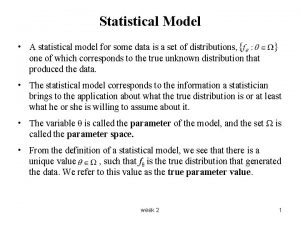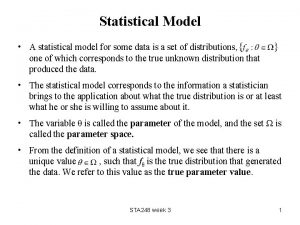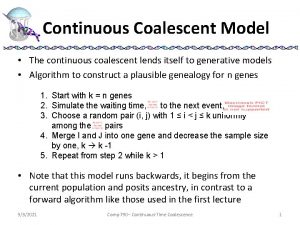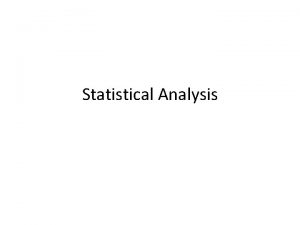Analysis of continuous dynamical systems using statistical model





![E+S Initial concentrations : [E 0] = 9 nmol/l [S 0] = 13. 5 E+S Initial concentrations : [E 0] = 9 nmol/l [S 0] = 13. 5](https://slidetodoc.com/presentation_image_h/ab0b293ae7b90cffd1c2fdbb4ee7390a/image-6.jpg)

















![E+S Initial concentrations : [E 0] = 9 nmol/l [S 0] = 13. 5 E+S Initial concentrations : [E 0] = 9 nmol/l [S 0] = 13. 5](https://slidetodoc.com/presentation_image_h/ab0b293ae7b90cffd1c2fdbb4ee7390a/image-24.jpg)
















![Sequential Probability Ratio Test (SPRT) [Wald, 1947] • Sequential Probability Ratio Test (SPRT) [Wald, 1947] •](https://slidetodoc.com/presentation_image_h/ab0b293ae7b90cffd1c2fdbb4ee7390a/image-41.jpg)
![Sequential Probability Ratio Test (SPRT) [Wald, 1947] Sequential Probability Ratio Test (SPRT) [Wald, 1947]](https://slidetodoc.com/presentation_image_h/ab0b293ae7b90cffd1c2fdbb4ee7390a/image-42.jpg)
















- Slides: 58

Analysis of continuous dynamical systems using statistical model checking P S Thiagarajan School of Computing National University of Singapore Joint work with: Sucheendra Palaniappan, Benjamin Gyori, Liu Bing, David Hsu

Continuous dynamical systems • Many physical systems interact with a digital controller. – automotive, avionics, manufacturing …. . • The key state variables will be real-valued evolving continuously over time. – Pressure, temperature, speed, … • The dynamics will be described by differential equations.

Differential equations x(0) = 2 The behavior of interest is the solution function. x(t) = t 3 + 4 t + x(0) = t 3 + 4 t + 2 x(t) 2

Plants and controllers PLANT actuators Sensors Digital Controller Plant dynamics: Differential equations Controller dynamics: Models of programs, ASICs, FPGAs, …. 4

PLANT actuators Sensors Digital Controller Given WCET analysis results what can we guarantee about the plant dynamics? Given the plant dynamics requirements (achieve stability within bounded time; stay only a bounded amount of time in a bad region) what should be the worst case performance? 5
![ES Initial concentrations E 0 9 nmoll S 0 13 5 E+S Initial concentrations : [E 0] = 9 nmol/l [S 0] = 13. 5](https://slidetodoc.com/presentation_image_h/ab0b293ae7b90cffd1c2fdbb4ee7390a/image-6.jpg)
E+S Initial concentrations : [E 0] = 9 nmol/l [S 0] = 13. 5 nmol/l [ES 0] = 0 nmol/l [P 0] = 0 nmol/l k 1 k 2 ES Rate constants : k 1 = 0. 1 l/(nmol*min) k 2 = 0. 1 min-1 k 3= 0. 3 min-1 k 3 E+P

Time (minutes) Concentration(n. M)

Where do we want to go with this?

Outline PART I – The behavior of a system of ODEs (ordinary differential equations). – A compact state space – IN, a set of initial states. – Behavior = TRJIN, the set of trajectories starting from IN.

Outline PART II – The specification logic. – BLTL (Bounded linear time temporal logic). – Interpreted at discrete time points: • 0, 1, 2, ……. , T – Finite discrete time horizon – Semantics:

Outline PART III – The (intractable) model checking problem: • TRJ = TRJIN ? • The probabilistic model checking problem: Pr(TRJ ) p ? – How to define Pr(TRJ How to define ) ? – C 1 continuity + theory of ODEs + measure theory

Outline PART IV – A statistical model checking (SMC) procedure to approximately solve “Pr(TRJ ) p ? ” PART V – A systems biology application

PART I: Behaviors S

PART I: Behaviors Reasonable constraint for physical and biological processes.

PART I: Behaviors Control systems must cope with a range of inputs The initial value of protein concentrations is usually a range of values.

PART I: Behaviors

PART I: TRJ – The set of trajectories. (t) IN 0 t The solution functions are trajectories. We want reason about all the trajectories.

PART II: Syntax of BLTL • BLTL – Bounded linear time temporal logic. • Syntax – ap = (i, l, u) is an atomic proposition. – At the current time point the value of the variable xi falls in the interval (l, u).

PART II: Syntax of BLTL

PART II: Semantics • We will interpret the formulas only at discrete time points: – 0, 1, 2, …. , T • Finite time horizon • For each there exists K (depends only on ) such that a prefix of length K of a model will determine if it is a model of . • Assume T is sufficiently large.

PART II: Semantics (t) 0 1 2 T The plant state will be sensed at only discrete time points. Experimental data will be available only at a finite number of time points.

PART II: Semantics

PART III: The model checking problem
![ES Initial concentrations E 0 9 nmoll S 0 13 5 E+S Initial concentrations : [E 0] = 9 nmol/l [S 0] = 13. 5](https://slidetodoc.com/presentation_image_h/ab0b293ae7b90cffd1c2fdbb4ee7390a/image-24.jpg)
E+S Initial concentrations : [E 0] = 9 nmol/l [S 0] = 13. 5 nmol/l [ES 0] = 0 nmol/l [P 0] = 0 nmol/l k 1 k 2 ES k 3 Rate constants : k 1 = 0. 1 l/(nmol*min) k 2 = 0. 1 min-1 k 3= 0. 3 min-1 It is impossible to solve this ODEs system explicitly. E+P

PART III: The probabilistic model checking problem. • Pr(TRJ ) p p (0, 1) • What does this mean? • A randomly selected trajectory in TRJ will be a model of with probability p. – Assuming a uniform distribution over IN. • NOTE: We are not trying to compute Pr(TRJ ).

PART III: The probabilistic model checking problem

PART III: The probabilistic model checking problem

PART III: The measurability of IN

PART III: Measurable functions Y

The flow functions

A simple observation

IN is measurable.

IN is measurable.

IN is measurable.

IN is measurable.

Part III: The result

PART IV: The SMC procedure

Statistical model checking… •

Statistical model checking… •

Statistical model checking…
![Sequential Probability Ratio Test SPRT Wald 1947 Sequential Probability Ratio Test (SPRT) [Wald, 1947] •](https://slidetodoc.com/presentation_image_h/ab0b293ae7b90cffd1c2fdbb4ee7390a/image-41.jpg)
Sequential Probability Ratio Test (SPRT) [Wald, 1947] •
![Sequential Probability Ratio Test SPRT Wald 1947 Sequential Probability Ratio Test (SPRT) [Wald, 1947]](https://slidetodoc.com/presentation_image_h/ab0b293ae7b90cffd1c2fdbb4ee7390a/image-42.jpg)
Sequential Probability Ratio Test (SPRT) [Wald, 1947]

PART IV: The SMC procedure

PART V: A systems biology application • Parameter estimation: – In an ODE model of a biochemical network many of the rate constants and initial concentrations (parameters) will be unknown. – One must estimate them using experimental data and some non-linear optimization technique.

E+S 0. 1 ES k 3 E+P

Parameter Estimation • Find values of parameter so that model prediction generated by simulations using these values can match experimental data krb. NGF = 0. 33, Km. Akt = 0. 16, kp. Raf 1 = 0. 42 … … target krb. NGF = 0. 49, Km. Akt = 0. 08, kp. Raf 1 = 0. 97 … … krb. NGF = 0. 88, Km. Akt = 0. 21, kp. Raf 1 = 0. 05 … … 11/27/2020 46

PART V: Parameter estimation • Randomly generate an initial set of parameter values • (A) Simulate and compare to experimental data. • (B) Update parameter values and repeat • How to update? – Most standard methods differ in the update phase, i. e. how to traverse the solution space 11/27/2020 47

PART V: Parameter estimation • For step (A) we use our SMC procedure. – cell-to-cell variability – Experimental data is usually about a cell population. • Code up quantitative experimental data and qualitative trends as a formula . • Choose p, , , • Run SMC to determine if Pr p + ( ) • Update using an evolutionary strategy based algorithm called SRES.







PART V: Other applications • We have carried out similar studies on a number of other pathways. • We have also applied our SMC procedure to perform global sensitivity analysis. • Details can be found in: [Palaniappn et. al: CMSB’ 13]

Extension: Hybrid systems

Summary • Analyzing the dynamics of an ODEs system is an important task. – In control applications – In systems biology • The SMC procedure is approximate but scalable; based on simulations. • A significant opportunity formal verification technologies.

Summary • We are not advocating this methodology as an alternative to ``exact’’ verification. • But it could be used as an initial probe into the system dynamics. • Further, in many situations approximate verification may suffice or may be the only option.
 Dynamical systems neuroscience
Dynamical systems neuroscience Motor development theories
Motor development theories Accelarationist
Accelarationist Automata
Automata Siam conference on applications of dynamical systems
Siam conference on applications of dynamical systems Repeat
Repeat Dynamical mean-field theory
Dynamical mean-field theory Dynamical
Dynamical Present past future continuous tense examples
Present past future continuous tense examples Present continuous past continuous future continuous
Present continuous past continuous future continuous Using statistical measures to compare populations
Using statistical measures to compare populations Statistical surface can be
Statistical surface can be Radar range equation snr
Radar range equation snr Object-oriented systems analysis and design using uml
Object-oriented systems analysis and design using uml Radar system analysis and design using matlab
Radar system analysis and design using matlab Neumans systems theory
Neumans systems theory Using the neuman systems model for best practices
Using the neuman systems model for best practices Statistical analysis system
Statistical analysis system Ascenex
Ascenex Preserving statistical validity in adaptive data analysis
Preserving statistical validity in adaptive data analysis Multivariate statistical analysis
Multivariate statistical analysis Cowan statistical data analysis pdf
Cowan statistical data analysis pdf Statistical business analysis
Statistical business analysis Marketing analytics software r
Marketing analytics software r Cowan statistical data analysis pdf
Cowan statistical data analysis pdf Statistical analysis of experimental data
Statistical analysis of experimental data Crd iii
Crd iii Modelo general de procesos
Modelo general de procesos Uiiss
Uiiss Promotions o'cool
Promotions o'cool Ac equivalent circuit of bjt
Ac equivalent circuit of bjt Using system.collections.generic
Using system.collections.generic Unit 25 special refrigeration system components
Unit 25 special refrigeration system components Peel past simple
Peel past simple Complete the sentences which
Complete the sentences which Make sentences using the past simple and past continuous
Make sentences using the past simple and past continuous Complete the sentences using present continuous
Complete the sentences using present continuous Simple past past perfect past continuous
Simple past past perfect past continuous Lesson 7: how to solve basic algebraic equations
Lesson 7: how to solve basic algebraic equations Solving systems using tables and graphs
Solving systems using tables and graphs Solve for y
Solve for y Solving word problems using systems of equations
Solving word problems using systems of equations Managing and using information systems
Managing and using information systems 3-6 solving systems using matrices
3-6 solving systems using matrices Modeling of digital communication systems using simulink
Modeling of digital communication systems using simulink Analyzing systems using data dictionaries
Analyzing systems using data dictionaries 6-3 solving systems using elimination
6-3 solving systems using elimination Modeling of digital communication systems using simulink
Modeling of digital communication systems using simulink Digital systems design using verilog
Digital systems design using verilog Ece 526
Ece 526 Global information management
Global information management 3-1 solving systems using tables and graphs
3-1 solving systems using tables and graphs 6-3 solving systems by elimination
6-3 solving systems by elimination Lesson 6-2 solving systems by substitution
Lesson 6-2 solving systems by substitution Use elimination to solve each system of equations
Use elimination to solve each system of equations Solving systems of equations by elimination steps
Solving systems of equations by elimination steps Solve each equation by substitution
Solve each equation by substitution 6-3 solving linear systems using inverses and cramer's rule
6-3 solving linear systems using inverses and cramer's rule Integration using tables and computer algebra systems
Integration using tables and computer algebra systems
